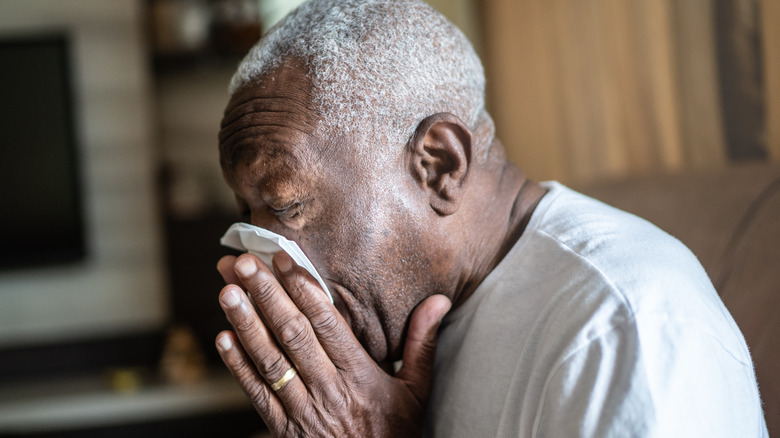Can You Die From A Nosebleed? What We Know
Excessive blood loss can be life-threatening, but how much blood is considered too much to lose? Healthline reports that a person is at risk of death when 50% of the body's blood supply is depleted. However, the body is able to withstand as much as 14% blood loss without any significant adverse effects, aside from perhaps feeling a little woozy.
Epistaxis, or a nosebleed, usually results in only minor blood loss. Most often, we experience anterior nosebleeds, which occur towards the front of the nasal cavity, according to 2022 research published in StatPearls. This area is routinely exposed to changes in temperature and moisture, and is particularly susceptible to injury. Less commonly, a person may suffer a posterior nose bleed. This type of epistaxis is considered more serious and often requires emergency intervention.
Although rare, nosebleed-related deaths are possible. Research shows that epistaxis accounts for four out of every 2.4 million deaths that occur annually in the U.S. (note that data from the Population Reference Bureau shows the annual number of deaths in the U.S. is now closer to 2.8 million as of 2019).
Potentially fatal nosebleeds have been linked with certain health conditions
Nosebleeds that result in death are more often seen in connection with specific health conditions. Researchers from an early 1961 article published in California Medicine note how potentially fatal cases of epistaxis have been associated with recent head trauma, vascular tumors in the nasal cavity, or severe arteriosclerotic cardiovascular disease (or heart disease that occurs due to hardening of the arteries), per Mayo Clinic.
Older adults may be more susceptible to potentially fatal posterior nosebleeds as they are more likely to be diagnosed with various health conditions. In a 2015 case report published in Federal Practitioner, researchers outlined the case of a veteran man in his mid-60s who was hospitalized after experiencing an on-and-off nose bleed over the course of 24 hours. The man was thought to have lost approximately 1 cup of blood throughout the day. His cause of death was attributed to stimulation of the body's trigeminocardiac reflex (TCR) that occurred following the medical intervention of nasal packing to stop the bleeding. This bodily reflex involves abrupt changes in numerous functions, including heart rate and blood pressure, in response to activation of the trigeminal nerve (via Frontiers in Neurology), a branch of which extends to facial areas including the nose (via Cleveland Clinic). As a result, the researchers emphasized the importance of exercising caution when treating older adults for posterior epistaxis.
When to seek medical attention for a nosebleed
Not all nosebleeds require medical treatment. For a mild case of epistaxis, Mayo Clinic experts advise sitting upright and leaning forward instead of tipping your head backwards, which can direct blood flow down the throat and increase the risk of choking. Next, softly blow your nose into a tissue before using your fingers to pinch your nostrils closed for anywhere between 10 and 15 minutes. If your nose is still bleeding, try pinching the nostrils shut again for another 15 minutes. If bleeding persists, you feel lightheaded, or you are bleeding more than expected, seek medical attention. The same is true if your nosebleed is related to physical trauma. You should also consult with your physician if nosebleeds are recurrent or if you use anticoagulant medications.
"If a nosebleed is severe enough that it can fill up a cup with blood, then we are in the territory of something where urgent medical attention is necessary," Dr. David A. Gudis, associate professor of otolaryngology/head & neck surgery at Columbia University Vagelos College of Physicians & Surgeons, told Columbia University Irving Medical Center. "And occasionally these can turn into life-threatening emergencies."



